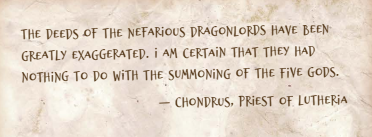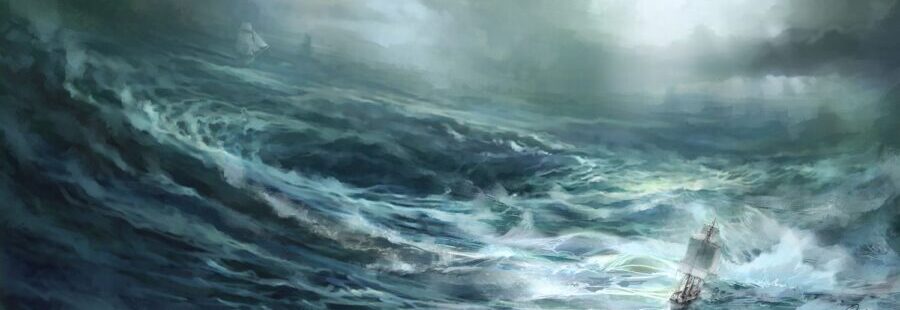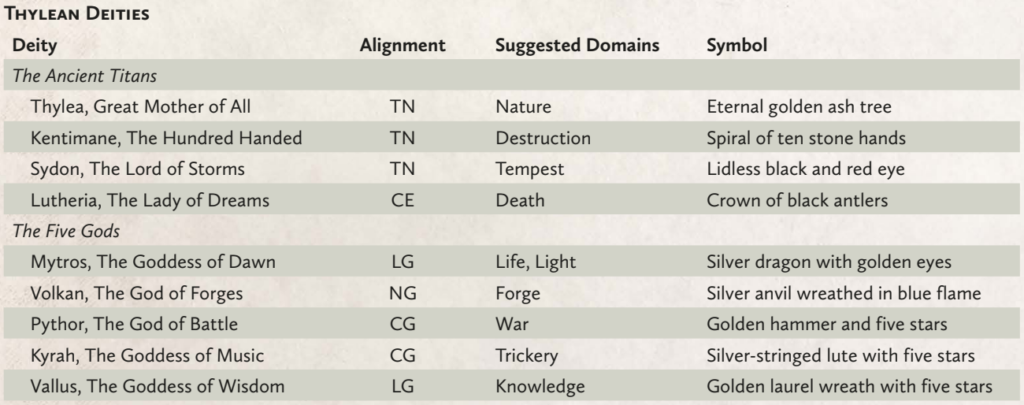History of Thylea
Arrival of Mortals
In the centuries before the founding of Mytros, mortals had no dominion over the untamed lands of Thylea. When elves, dwarves, and humans washed up on Thylea’s shores, their weapons failed them, and their magic ceased to work. They were forsaken by their gods, forced to live as beggars among the fey races.
Curious about these strange refugees, the nymphs and satyrs offered them hospitality, and many small settlements were founded. The centaurs, however, offered them no quarter, and the cyclopes were known to devour men whole. Life in Thylea was short and brutal for the so-called ‘trespassers’ from foreign lands.
During this era, the Twin Titans wielded great powers, unlike anything seen since the dawn of time. Sydon was venerated as the Lord of Storms. He could conjure apocalyptic storms with his right hand and cataclysmic earthquakes with his left hand. His sister-wife Lutheria held dominion over the land of dreams, and her voice was said to give life to the dead.
Fearing eradication, the desperate mortal settlers built shrines to Sydon and held feasts in Lutheria’s honor. Thousands of sacrifices were dedicated to the Lord of Storms, and libations of wine were poured to the Lady of Dreams at every meal. The twins were at first unswayed but, over time, they warmed to the persistent worship of the hapless settlers.
In exchange for this devotion, the Titans offered the mortals oaths of protection, which shielded them from the worst ravages of the centaurs and cyclopes. The settlements survived, but they were always at the mercy of the Twins. So it remained for many hundreds of years.
Timeline of Thylean History
- ~2,000 DA – Height of the Gygan empire
- 24 DA – Arrival of the Dragonlords
- 18 DA – Founding of the first settler kingdoms
- 14 DA – The First War begins
- 12 DA – Sydon kills the last dragon
- 10 DA – The Five Gods appear
- 1 DA – Mytros ascends to the heavens
- 0 CE – The Oath of Peace is sworn
- 1 CE – Founding of the Kingdom of Mytros
- 28 CE – Disappearance of the Ultros
- 35 CE – Construction of the Necropolis
- 125 CE – The Aresian campaigns begin
- 330 CE – Pythor becomes king of Estoria
- 370 CE – The Kraken destroys one of the Colossi
- 400 CE – The last great Aresian campaign ends
- 468 CE – Acastus becomes King of Mytros
- 500 CE – The Oracle’s Prophecy (Now)
Arrival of the Dragonlords
One fateful day, a flight of powerful bronze dragons arrived on Thylea’s shores, each bearing a great champion from the Old World. These were the legendary warriors known as the Dragonlords, and they heralded an upheaval that would forever change the history of the Forgotten Land.
Within just a few years of their arrival, many small cities were founded, and a half-dozen small kingdoms sprang up along the roads of the western reaches. The Dragonlords founded powerful dynasties, and the humble mortals who had once lived in terror of the Titans now abandoned their temples and stood tall.
The Dragonlords were symbols of hope for a beleaguered people. Whenever any mortal settlement was razed to the ground by roving centaurs and cyclopes, the Dragonlords would repay the attackers in kind. Through harsh winters, blistering summers, and relentless assaults by the native races, the Dragonlords fought tirelessly, and the people of Thylea persevered.
Everywhere the dragons were greeted with shouts of adulation. When spotted flying overhead, they would be hailed as saviors, and great songs and feasts would be held in their honor. They were radiant to behold, bronze scales gleaming like fire. To be visited by one of the dragons was to be blessed; and nowhere was more blessed than the City of Mytros.
But the great powers that ruled Thylea grew jealous. Sydon and Lutheria, the Twin Titans, immortal children of the mother goddess, amassed great armies to eradicate the city. The Dragonlords responded by gathering all the mortals in Thylea into a united assault on the native races, and so began the First War.
The First War
The histories of the First War are vague, having been passed down through the centuries in the form of decaying scrolls and tapestries. What is known for certain is that the native races were driven into exile. The centaurs retreated into the steppes, while the satyrs fled into the forests. The Gygans, an ancient civilization of cyclopes, were annihilated, leaving behind the crumbling ruins of their fallen cities.
The cost of victory was great: by the time the war ended, the last of the dragons had been killed defending the city they loved most. Although the Dragonlords are remembered as the great heroes of this age, their noble dragons came to be equally venerated as guardian spirits. The blood of their sacrifice is woven into the stones of Mytros, and to this day the city is said to glow radiant bronze at sunset.
Perhaps most miraculous of all, however, was the appearance of the Five Gods. These immortal figures descended from heaven when the tide had turned against the Dragonlords. Some have claimed that they were manifestations of Thylea’s own desire to protect her immigrant children. They took the form of mortal men and women, but their eyes were alight with the fire of divinity.
Each of these new gods manifested some portion of the power that had once belonged to the Titans. Pythor, the Lord of Battle, took command of the centurions of Mytros and, after many gruesome battles, the armies of the native races were broken. When the final spear had been thrust into the heart of the Gygan King, the Five Gods fell into a torpor, apparently to recover their strength. The city, it seemed, was safe.
But Sydon and Lutheria swore vengeance. The mountains shook, the seas boiled with rage, and spine-chilling nightmares descended upon the mortal armies. Such was the anger of the Titans that their retaliation threatened to sunder the very foundations of Thylea.
In the end, Mytros, the goddess of dawn, sacrificed herself and ascended once more to the heavens in order to rescue her beloved city from destruction.

The Oath of Peace
Having lost their mounts, the Dragonlords commissioned a fleet of warships and took to the seas. The greatest of these ships was called the Ultros, captained by one Estor Arkelander. He is said to have sailed into the very depths of the underworld where Lutheria sleeps upon her diamond throne. The other Dragonlords are said to have ascended Phraxys, the Tower of Sydon, where the Lord of Storms watches all.
Many songs are sung of the trials and troubles of the Dragonlords, but few can say what actually transpired during their final journey into the perils of the Forgotten Sea. The priests of Mytros watched for signs of the impending apocalypse. On the night of the winter solstice, when Thylea’s doom seemed near, the boiling seas suddenly calmed and the nightmares ended.
Some days later, a black ship sailed into the harbor of Mytros, carrying the bodies of many of the Dragonlords. The ship was captained by Damon, a powerful wizard who had served the Dragonlords during the First War. He was mortally wounded, but he uttered not a single word. He delivered three precious items to the Temple of the Five, and then vanished in his ship, along with the bodies and arms of his fallen masters.
One of the items that Damon carried was a scroll of parchment, upon which was written the Oath of Peace. This Oath was cause for great celebration. Sydon and Lutheria had sworn not to take vengeance upon the mortals of Thylea for a period of 500 years, provided that daily sacrifices to the Titans should resume, and that their temples should be maintained and honored.
The Present Day
The Oath of Peace has prevailed for 500 years and, throughout this age, the mortals of Thylea have flourished. The City of Mytros grew into a great metropolis, and it has been protected by the twin Colossi, beacons of civilization on the shores of a dark frontier. More settlers came from beyond the Forgotten Sea, and the ranks of humans, dwarves, and elves grew. The remaining Dragonlords became kings and established dynasties to rule over the new cities that were founded across the land. As the worship of the Five spread, so also did their power over the land and oceans grow, until every village boasted shrines to Volkan and Pythor, and the dominion of Sydon and Lutheria was nearly forgotten.
The Five Gods loved their people and made sure to walk amongst them whenever they could.
While five centuries may seem like an eternity, the time now grows near where this period of peace must finally come to an end.
With the imminent end of the Oath of Peace, the Oracle has prophesied the Doom of Thylea: the death of the gods, the destruction of the sacred tree, and the total annihilation of all mortal races.
Traveling to Thylea

Adventurers who explore the oceans of their world to their farthest reaches will eventually discover the Maelstrom: a terrifying region of hurricanes, whirlpools, and jagged rocks. Drunken sailors often boast of death-defying encounters within the Maelstrom, but none who have sailed its waters have ever returned.
Adventurers who brave the Maelstrom must spend days battling storms, skirting whirlpools, and navigating through treacherous shoals. The passage is so intense that the crew is likely to be rendered unconscious. Lucky adventurers will awaken in calmer waters, under a cloudless sky—a glittering green expanse known as the Forgotten Sea.
The Forgotten Sea stretches for hundreds of miles in every direction, and it boasts hundreds of islands. Powerful ocean currents prevent ships from approaching these islands, and any attempt to do so will cause a ship to lose control and be smashed on a rocky shoreline.
Watchful sailors may glimpse strange things on the islands: impossibly tall humans in fine clothing, monstrous reptilian beasts, and great stone carvings in the shape of human faces. Intrepid explorers will eventually catch sight of a towering bronze colossus shining brightly on the horizon. This beacon serves to guide ships into the harbor of Mytros, the greatest city in Thylea.
The Powers of Thylea
The Ancient Titans
The Titans are divine powers native to Thylea. They have existed since the dawn of time.
Thylea, Great Mother of All
Thylea is the namesake of the Lost Land. She takes the form of a gargantuan tree on an island at the heart of the Cerulean Gulf, and her followers believe that her roots reach deep into the earth, binding the world together in an eternal embrace. Thylea is believed to be a generous, life-giving goddess. The Druids of the Oldwood believe that her will is communicated through the changing of the seasons, rather than through words. Long winters, for example, signal her displeasure; long summers are a sign of her approval.
Kentimane, The Hundred Handed
Kentimane was the most powerful of the Titans. He is believed to be both the husband and eternal guardian of the Great Mother. Many references are found to him in the poetry of the gygans and the centaurs, but few credible sources have survived the ravages of time. Kentimane is usually depicted with one hundred heads and one hundred hands.
Sydon, The Lord of Storms
Sydon is the Lord of the Oceans and all that flows from them. He takes the form of a colossal, bearded man with three eyes, and he carries a terrifying black glaive. He surveys both land and water tirelessly, summoning storms to punish those who displease him. Sydon is a jealous and vengeful god who makes no allowances for the worship of any god but himself or his sister-wife, Lutheria. Every temple in Thylea fears the wrath of Sydon. Daily sacrifices are offered to him in every village, even as the settlers continue their silent prayers to the Five. Whenever thunder rolls through the skies of Thylea, you can be sure that someone has provoked Sydon’s anger.
Lutheria, The Lady of Dreams
Lutheria takes the form of a beautiful, black-eyed woman who sleepwalks through the underworld, greeting the spirits of the dead. She carries a crystal scythe, which she uses to harvest the souls of those who displeased her in life. Lutheria commands her followers to live without remorse, to drink, dance, and feast to their heart’s desire, because any day could be their last. She is a mother to the fey races of Thylea, who she strongly favors.
Worship of Lutheria is rare among settlers, but she is nevertheless honored with many feasts and festivals because Sydon demands it. Whenever any drink is poured, a libation must be made to Lutheria or else a swift punishment is sure to follow.
The Five Gods
The Five Gods are widely celebrated as the settlers’ favored gods. With the exception of Mytros, they are not heaven-dwelling deities but familiar faces who walk among their people. They have been known to take mortal husbands and wives, rule over cities, and sire demi-god children. They helped the Dragonlords and the mortal races to defeat Sydon and Lutheria during the First War. For centuries, they have blessed the mortal races, protecting them from tyrannical domination by Sydon and Lutheria.
Shrines to the Five gods can be found in nearly every settler household. Prayers to the Five must be accompanied by the sign against the evil eye to ward off the jealous gaze of Sydon and Lutheria.
Mytros, The Goddess of Dawn
Mytros, called by some the ‘Silver Queen’ is the most benevolent of the Five Gods and the patron goddess of the most important kingdom in Thylea. She is widely credited with the survival of the city during the destruction and aftermath of the First War, and she is said to appear to her priests as a warrior queen clad in shimmering golden armor. Having ascended to the heavens after a cataclysmic battle with Sydon and Lutheria, she no longer walks among mortals. She is the most powerful of the Five Gods, and the source of most priestly magic in Thylea.
Volkan, The God of Forges
Not much is known about Volkan except that he is the husband of Mytros. He concerns himself with artifice and crafting and is primarily worshipped by dwarves, smiths, and wizards. He is depicted as an elderly and wise-looking man (and sometimes as a dwarf). He is rumored to travel through the Heartlands on the winter solstice, distributing toys and sweets to children.
Pythor, The God of Battle
A son of Mytros and Volkan, Pythor appeared to the settlers during the First War and fought tirelessly against the centaurs and gygans that threatened to The goddess of dawn took her name from the city she loved. She died protecting Mytros during the First War and ascended to the heavens. We humble priests still draw upon the power of her magic. — Aesop of the Dragon Shrine Mytros, the Goddess of Dawn overwhelm the city of Mytros. His praises were sung for centuries after, and he is said to have walked among the settlers in mortal guise, taking women to his bed and fathering demi-god children. A few centuries ago he became the king of the city of Estoria when he overthrew a mad tyrant.
Vallus, The Goddess of Wisdom
Vallus is revered as the goddess of wisdom and beauty, and she is believed to know as much about Thylea’s history as Sydon and Lutheria. She was once known to travel far and wide, surveying ancient ruins and collecting lore concerning the origins of the land and the fey races. Prayers are offered to Vallus when guidance is needed and information is scarce. She is the oldest daughter of Mytros and, in many ways, she has inherited her mother’s legacy, serving as both queen and patron goddess to the city.
Kyrah, The Goddess of Music
Kyrah is revered as the trickster goddess of music and poetry. She is the swiftest of all the gods, capable of disappearing in the blink of an eye and she can travel great distances with each step. Her voice is said to be more beautiful than any musical instrument. There are very few shrines to her, except among bards, who revere her as the Muse.
